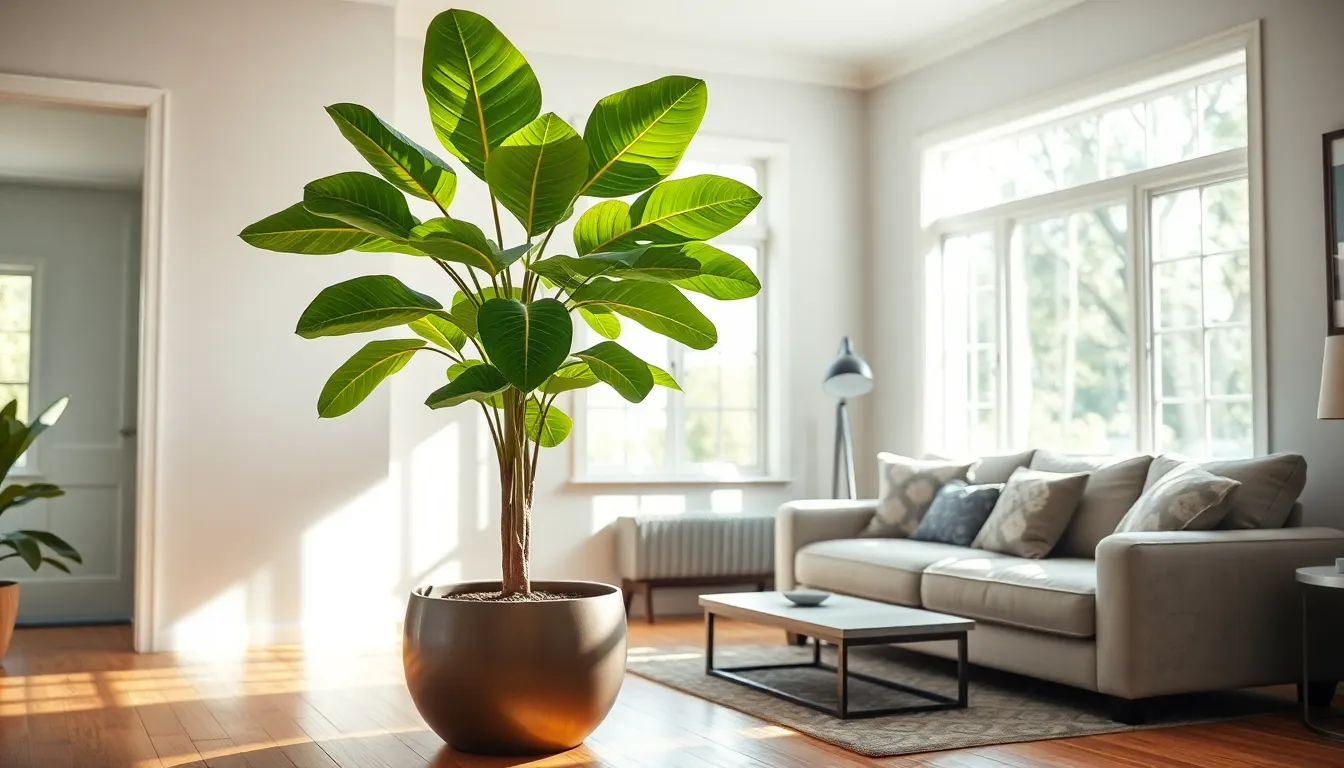Best Indoor Tree: Transform Your Home with These Stunning Green Beauties

Bringing a touch of nature indoors can transform a dull space into a vibrant oasis, and what better way to do that than with the best indoor tree? These leafy companions not only purify the air but also add a splash of personality to any room. Imagine a towering fiddle leaf fig or a charming rubber plant gracing your living room, making your guests green with envy—or at least a bit jealous of your excellent taste in home decor.
Best Indoor Tree
Indoor trees offer numerous advantages, enhancing both aesthetics and air quality. They not only beautify spaces but also promote emotional well-being by creating a calming environment. Popular choices include the fiddle leaf fig, known for its large, vibrant leaves, and the rubber plant, notable for its glossy foliage.
Both plants thrive in indirect light, making them ideal for various indoor settings. Their ability to filter indoor pollutants contributes to a healthier living space, promoting better air quality. Many indoor trees, such as the snake plant and ZZ plant, require minimal care, appealing to novice plant owners.
Different indoor trees serve distinct purposes. For example, the dracaena serves as a stunning focal point, while the money tree symbolizes good fortune. Both the parlor palm and bamboo palm add tropical flair and adapt well to various room conditions. With their diverse sizes and leaf shapes, they cater to different decorating styles.
Height matters when selecting an indoor tree. Taller trees, like the ficus, often work well in spacious areas, while smaller options, such as the pothos plant, fit snugly on shelves. Categorizing indoor trees based on light requirements helps streamline the selection process.
Incorporating indoor trees enhances not only the visual appeal of a room but also improves overall air quality and mood, providing a striking balance between nature and home decor. Selecting the right indoor tree aligns with personal style and lifestyle preferences, ensuring satisfaction for both plant and owner.
Benefits of Having Indoor Trees

Indoor trees offer numerous benefits that enhance living spaces. These plants contribute significantly to air quality, aesthetic appeal, and stress relief.
Air Quality Improvement
Indoor trees actively improve air quality by filtering toxins. Plants like the rubber plant and snake plant absorb pollutants such as formaldehyde and benzene, making the air cleaner. Research indicates that having indoor greenery can reduce carbon dioxide levels, promoting a healthier atmosphere. Maintaining plants also increases humidity levels, which is beneficial for respiratory health. The presence of indoor trees encourages better air circulation, further enhancing indoor environments.
Aesthetic Value
Indoor trees add a striking aesthetic element to any space. Their lush foliage creates visual interest and can become a focal point in room design. A fiddle leaf fig, for instance, elevates the decor with its dramatic leaves. Additionally, indoor trees come in various sizes and shapes, allowing for diverse styling options. Whether in a corner or as a centerpiece, these plants enhance the ambiance and impress guests with their natural beauty.
Stress Reduction
Indoor trees promote relaxation and reduce stress levels. Studies show that interacting with plants can lower cortisol levels, contributing to emotional well-being. The calming presence of greenery fosters a serene environment, making spaces feel inviting and peaceful. Incorporating trees into living areas encourages mindfulness and connection with nature. This natural element offers a quick escape from daily pressures, improving overall mood and mental clarity.
Top Picks for the Best Indoor Tree
Indoor trees enhance home decor and promote well-being. Here are some top selections:
Fiddle Leaf Fig
Fiddle leaf figs are popular indoor trees known for their large, glossy leaves. This tree thrives in bright, indirect light, making it a perfect centerpiece in living rooms. Regular watering ensures it remains vibrant, but overwatering can lead to root rot. With proper care, this tree can grow up to six feet tall, creating striking visual interest in any space.
Snake Plant
Snake plants stand out for their striking, sword-like leaves. Resilient and low-maintenance, they tolerate low light and infrequent watering. This tree excels at filtering indoor air pollutants, contributing to a healthier living environment. Growing up to three feet tall, snake plants add an attractive architectural element while being virtually carefree for novice plant owners.
Rubber Plant
Rubber plants are favored for their lush, deep green foliage and robust growth. They flourish in bright, indirect light, though they adapt well to lower light conditions. Regular watering promotes healthy growth, but allowing the top inch of soil to dry out between waterings avoids overwatering. These trees can reach heights of up to eight feet, making them an impressive addition to any room.
Areca Palm
Areca palms provide a tropical flair and lush appeal to indoor spaces. They thrive in bright, indirect light and require moderate watering to keep the soil slightly moist. This palm tree efficiently filters toxins, promoting a healthier atmosphere in homes. Growing up to six to seven feet tall, the areca palm can serve as an eye-catching focal point while enhancing the overall ambiance of a room.
Care Tips for Indoor Trees
Caring for indoor trees involves understanding their specific needs, including light, water, soil, and fertilization. Proper care enhances growth and keeps these plants healthy.
Light Requirements
Indirect light suits most indoor trees. Position plants near east or west-facing windows to provide adequate brightness while avoiding direct sunlight. For instance, the fiddle leaf fig thrives in bright but filtered light, while the snake plant tolerates lower light conditions. Assessing light levels weekly can help determine if plants require relocation. Observing leaves for signs of stress, like yellowing or browning, can indicate lighting issues needing attention.
Watering Needs
Watering requirements vary by species. Rubber plants prefer consistently moist soil, while snake plants need infrequent watering, allowing the soil to dry between sessions. When watering, observe for excess moisture in the pot, which can cause root rot. Testing soil moisture with a finger can prevent overwatering, ensuring a healthy balance. A general rule is to water every 1 to 2 weeks, adjusting frequency seasonally based on humidity and temperature changes.
Soil and Fertilization
Well-draining soil supports healthy indoor trees. A mix of potting soil and perlite usually provides adequate drainage. Fertilization during the growing season enhances growth; typically, a balanced liquid fertilizer applied monthly works well. Adjust fertilization frequency based on plant response and growth rate. Observing growth patterns in each species allows for tailored care, ensuring that plants receive the necessary nutrients for optimal health.
Conclusion
Bringing indoor trees into a home can transform any space into a vibrant oasis. These plants not only enhance decor but also contribute to a healthier living environment. With options like the fiddle leaf fig and rubber plant, anyone can find the perfect fit for their home.
Caring for indoor trees can be simple and rewarding. By understanding their specific needs, individuals can ensure their plants thrive. The emotional and physical benefits of having greenery indoors are undeniable, making indoor trees an excellent choice for anyone looking to boost their home’s ambiance and well-being.



